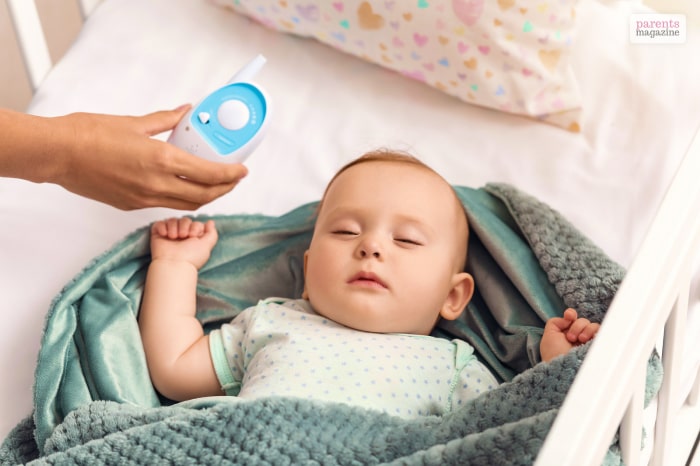
Learn Best Sleeping Position for A Baby with a Stuffy Nose!
It gets messy and difficult when your little one can hardly sleep because they are all snotty and have a stuffed nose.
They can hardly eat, cry, or sleep properly when their nose is stuffed with mucus. Most importantly, it becomes difficult for the baby to sleep with snot stuffing their nose. Unless you put them to bed in a good position, they may feel suffocated.
In this article, we have talked about the best sleeping position when your baby is dealing with a stuffed nose. Continue reading this article for further information.
What is the Best Sleeping Position for a Baby with a Stuffy Nose?

The best sleeping position for babies with a stuffy nose is to make them sleep on their backs. Per the AAP (American Association of Pediatrics), placing your baby on a firm and flat surface on their back is best.
Also, do not elevate the baby’s head while placing them on their back. This does not help reduce congestion in their nose. Many parents might think that putting a pillow or a mattress under the baby’s head makes nasal congestion easier. But that’s not true.
Doing so will only narrow their airways, and the baby will have less air while sleeping. Also, an elevated head position makes their neck bend forward and restricts their narrow airways.
Also, avoid putting your baby to sleep in a car seat or lying in a baby carrier. It’s best to take them to a flatter surface for sleep.
It’s alright if the baby is falling asleep on the lap of a caregiver. There’s no harm in holding the baby while they are asleep. However, the caregiver must stay awake while the baby is sleeping in their lap. The chances of sleep-related infant death grow high if the caregiver is also sleeping with the baby in their lap.
So, if the baby has a stuffy nose, the best position for them to fall asleep would be on their back while lying on a hard surface.
Risks Associated with Baby Sleeping with Stuffy Nose

A stuffy nose can cause several risks for a little baby. Some common risks include –
Sleep Disturbances: it can interrupt the baby in the middle of their sleep. This can cause poor quality of sleep.
Feeding Difficulties: Babies under the age of 6 months often have sleep difficulty following sleep disturbances. This can also interrupt the sleep cycle of the caregiver as well.
Ear Infections: Mucus drainage from the stuffy nose can also plug the eustachian tube, which connects the ear and the nose. It can lead to ear infections.
Dehydration: With a stuffy nose, the baby has an interrupted sleep rhythm (suck-swallow-breath). It can also lead to dehydration.
What to do if the Baby Likes to Sleep with a Stuffy Nose?

The baby has a stuffy nose and sleeping on its tummy. So, is that harmful? The AAP recommends putting the baby to sleep on their back. However, there shouldn’t be any problem if the baby rolls on its tummy occasionally when asleep.
If the baby can roll on its tummy and onto the back again, it’s quite normal to sleep on the tummy. There’s no need to change their position every time the baby rolls onto his tummy.
But make sure to keep the sleeping surface clutter-free. There shouldn’t be any side pillows, stuffed animals, or toys on the baby’s bed. Having these things can block the baby’s airways during sleep.
So, if you are wondering what’s the best sleeping position for a baby with a stuffy nose at night, put them to sleep on their back.
Best Sleeping Position for Baby with Stuffy Nose: Tips

Your baby needs the best quality sleep to relieve a stuffy nose, it’s difficult for them to fall asleep When they have a snotty nose. But you can try some tips we have given below to help your little one sleep better with a congested nose.
Cool Mist Humidifier & Steam Treatment

While putting your baby to sleep on their back does help, here’s another tip to help cure that nasal congestion. Put a cool humidifier or a vaporizer in your baby’s room before they fall asleep. Do place it out in the open and keep it close enough to help reduce congestion in our baby’s nasal passage. But make sure to put it away from your baby’s reach.
For the best result, clean the humidifier on a regular basis. These machines may require you to replace the water regularly. Also, follow the manufacturer’s instructions while cleaning to prevent Molds or bacteria from building up inside.
Use the steam treatment when the baby’s nose is extra congested. You can use a bowl of hot water and bring your baby close to the bowl. Or you run hot water in the bathroom while leaving the doors closed. Once the air inside is filled with steam, take your baby inside and snuggle them as they breathe the steamy air. Leave the room and put your baby to sleep if they feel uncomfortable.
Gentle Suction

Use saline drops or a gentle suction method to treat your baby’s congested nose before putting them to sleep. Try the best sleeping position for babies with stuffy noses to help them sleep easily. But the sleep quality improves when the baby has less snot or fluid stored inside their nose.
Put some drops of saline inside the baby’s nose. This will help reduce the congestion. Now, use a bulb s syringe to remove the mucus from their nasal passage carefully. Next, use a cotton swab to carefully remove the mucus.
However, it may not be necessary if your baby has no extreme congestion or stuffy nose.
Provide Proper Hydration

Ensure that your little one is properly hydrated when they have a stuffy nose. Babies aged under 6 months can get their hydration from formula or breastmilk. Babies above 6 months can also have water to stay hydrated during this period.
Proper hydration helps your baby when they have colds and congestion in their nose. In addition, it has several other benefits like –
- Helping the baby regulate their body temperature.
- Preventing dehydration.
- Thinning the mucus that causes congestion, provides better quality sleep and eating experience.
When your baby is feeling too congested, keep them in an upright position after feeding. Hold your baby upright Instead of lying them down, to reduce the chance of spitting up or vomiting. After feeding, make sure to keep the baby in an upright position for a while before they go to sleep.
Should You Call the Doctor?

You can change the position of your baby’s sleep. But, sometimes, the condition may worsen. In those cases, it’s best not to rely only on the home remedies we have recommended. If your baby has something more than cold or breathing troubles, go forward and take them to a doctor.
But how do you know that your baby needs medical attention? Well, you may look out for changes in their eating behavior, mood, and breathing difficulty.
Here are some extreme and alarming symptoms when your baby has a cold. If you see any of these signs, call 911 immediately –
- Look for signs like the baby struggling to breathe.
- Do they struggle to take a deep breath?
- Check if their face and lips are turning bluish.
- Something might be stuck in their throat.
However, some symptoms may suggest you must take your baby to the doctor. Those symptoms include
- The baby is breathing faster than normal.
- While coughing, the baby’s face turns blue.
- The baby cannot sleep or eat due to constant coughing.
Final Words
It’s quite common for babies to be exposed to a viral infection, which is causing extreme levels of cold and cough. It’s best to communicate with a paediatrician and know whether a viral infection is causing this. However, it’s best to put them to sleep on their back to reduce the chances of suffocation and other difficulties.
However, if you see any of the alarming signs I have mentioned in this article, consult with the pediatricians first.
You May Like To Read This:
Already have an account?
Sign In
Create your account
User added successfully. Log in








